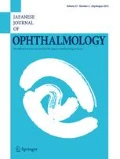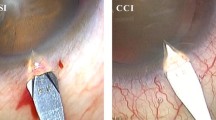Abstract
Purpose
To compare the intraocular pressure (IOP) and wound state immediately after cataract surgery for eyes with a long clear corneal incision (CCI) with those for eyes with a short CCI.
Study design
Randomized clinical trial.
Methods
One hundred twenty-eight eyes of 128 patients scheduled for phacoemulsification were randomly assigned to undergo long (≥ 1.75 mm) or short (< 1.75 mm) CCI (2.4-mm wide). IOP was measured using a rebound tonometer preoperatively, at the conclusion of surgery, and at 30 min, 60 min, 120 min, 180 min, and 24 h postoperatively. Wound architecture determined using anterior segment-optical coherence tomography and flare intensity was examined at 60 min postoperatively.
Results
The mean incision length was significantly longer in the long CCI group (2.02 ± 0.19 mm) than in the short CCI group (1.50 ± 0.13mm; P < .0001). The mean IOP significantly increased at 120 min and 180 min postoperatively (P ≤ .0005) and returned to the preoperative level within 24 h. The mean IOP did not differ significantly between the long and short CCI groups at any follow-up period. The incidence of IOP lower than 10 mmHg did not differ significantly between the groups. The mean flare intensity was significantly greater in the short CCI group than in the long CCI group (P = .0122). The wound architecture was similar between the groups.
Conclusion
IOP and wound architecture were comparable between eyes with a long CCI and eyes with a short CCI in the immediate postoperative periods up to 24 h, suggesting that wound stability is equivalent when the CCI is securely closed with wound hydration.



Similar content being viewed by others
References
Sarayba MA, Taban M, Ignacio TS, Behrens A, McDonnell PJ. Inflow of ocular surface fluid through clear corneal cataract incisions: a laboratory model. Am J Ophthalmol. 2004;138:206–10.
Herretes S, Stark WJ, Pirouzmanesh A, Reyes JM, McDonnell PJ, Behrens A. Inflow of ocular surface fluid into the anterior chamber after phacoemulsification through sutureless corneal cataract wounds. Am J Ophthalmol. 2005;140:737–40.
Chawdhary S, Anand A. Early post-phacoemulsification hypotony as a risk factor for intraocular contamination: in vivo model. J Cataract Refract Surg. 2006;32:609–13.
May W, Castro-Combs J, Camacho W, Wittmann P, Behrens A. Analysis of clear corneal incision integrity in an ex vivo model. J Cataract Refract Surg. 2008;34:1013–8.
McDonnell PJ, Taban M, Sarayba M, Rao B, Zhang J, Schiffman R, et al. Dynamic morphology of clear corneal cataract incisions. Ophthalmology. 2003;110:2342–8.
Berdahl JP, DeStafeno JJ, Kim T. Corneal wound architecture and integrity after phacoemulsification: evaluation of coaxial, microincision coaxial, and microincision bimanual techniques. J Cataract Refract Surg. 2007;33:510–5.
Calladine D, Packard R. Clear corneal incision architecture in the immediate postoperative period evaluated using optical coherence tomography. J Cataract Refract Surg. 2007;33:1429–35.
Behrens A, Stark WJ, Pratzer KA, McDonnell PJ. Dynamics of small-incision clear cornea wounds after phacoemulsification surgery using optical coherence tomography in the early postoperative period. J Refract Surg. 2008;24:46–9.
Hayashi K, Yoshida M, Hirata A, Yoshimura K. Changes in shape and astigmatism of total, anterior, and posterior cornea after long- versus short corneal incision cataract surgery. J Cataract Refract Surg. 2018;44:39–49.
Chylack LT Jr, Wolfe JK, Singer DM, Leske MC, Bullimore MA, Bailey IL, et al. The lens opacities classification system III: the longitudinal study Of Cataract Study Group. Arch Ophthalmol. 1993;111:831–6.
Hayashi K, Ogawa S, Yoshida M, Yoshimura K. Wound stability and surgically induced corneal astigmatism after transconjunctival single-plane sclerocorneal incision cataract surgery. Jpn J Ophthalmol. 2017;61:113–23.
Hayashi K, Tsuru T, Yoshida M, Hirata A. Intraocular pressure and wound status in eyes immediately after scleral tunnel incision and clear corneal incision cataract surgery. Am J Ophthalmol. 2014;158:232–41.
Salim S, Du FH, Wan J. Comparison of intraocular pressure measurements and assessment of intraobserver and interobserver reproducibility with the portable ICare rebound tonometer and Goldmann applanation tonometer in glaucoma patients. J Glaucoma. 2013;22:325–9.
Brusini P, Salvetat ML, Zeppieri M, Tosoni C, Parisi L. Comparison of ICare tonometer with Goldmann applanation tonometer in glaucoma patients. J Glaucoma. 2006;15:213–7.
Sahin A, Basmak H, Niyaz L, Yildirim N. Reproducibility and tolerability of the ICare rebound tonometer in school children. J Glaucoma. 2007;16:185–8.
Mackool RJ, Russell RS. Strength of clear corneal incisions in cadaver eyes. J Cataract Refract Surg. 1996;22:721–5.
Acknowledgements
The authors thank SciTechEdit International (Highlands Ranch, CO, USA) for editorial assistance and Kozi Yonemoto, PhD, (Ryukyu University, Okinawa, Japan) for statistical assistance.
Author information
Authors and Affiliations
Corresponding author
Ethics declarations
Conflicts of interest
K Hayashi, Grant (Abbott Medical Optics, Alcon, HOYA, Santen Pharmaceutical, Wakamoto); H. Sasaki, Grant (Abbott Medical Optics, Alcon, HOYA, Santen Pharmaceutical, Wakamoto); S. Manabe, Grant (Abbott Medical Optics, Alcon, HOYA, Santen Pharmaceutical, Wakamoto); A. Hirata, Grant (Abbott Medical Optics, Alcon, HOYA, Santen Pharmaceutical, Wakamoto).
Additional information
Corresponding author: Ken Hayashi
About this article
Cite this article
Hayashi, K., Sasaki, H., Manabe, Si. et al. Intraocular pressure and wound state immediately after long versus short clear corneal incision cataract surgery. Jpn J Ophthalmol 62, 621–627 (2018). https://doi.org/10.1007/s10384-018-0626-1
Received:
Accepted:
Published:
Issue Date:
DOI: https://doi.org/10.1007/s10384-018-0626-1




